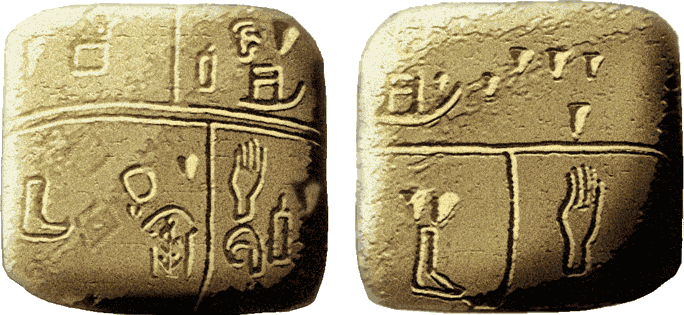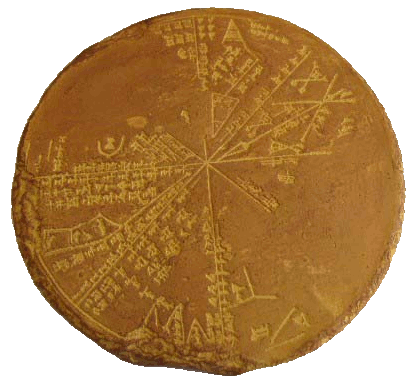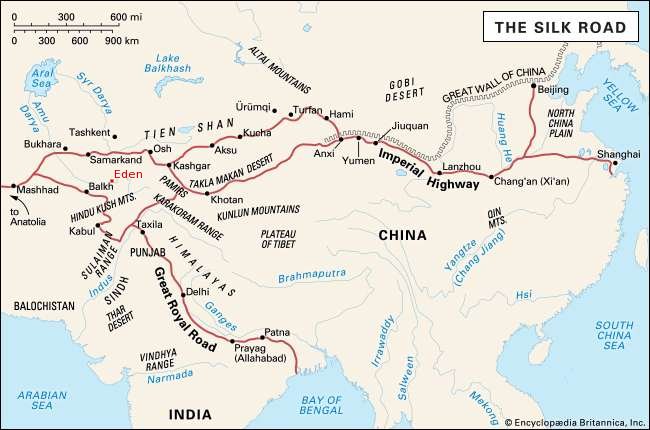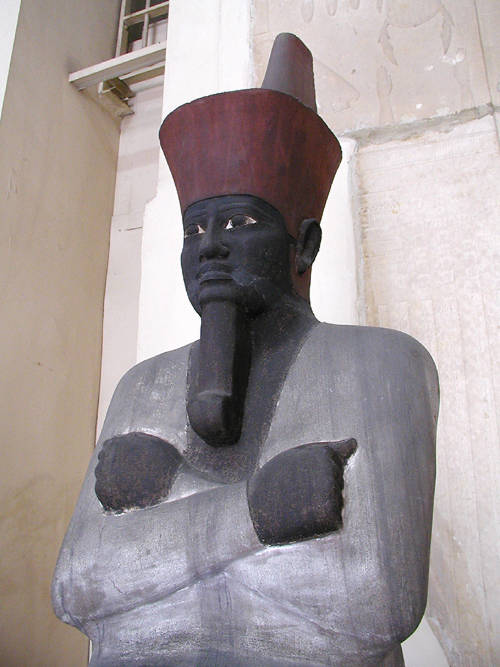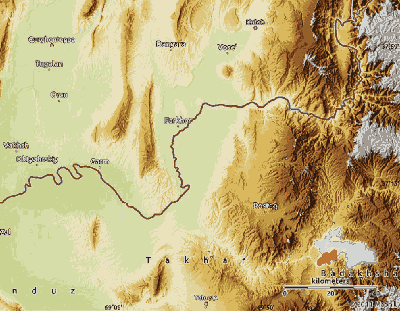© Charles ChandlerHaving fixed Abraham's birth in , we can estimate the dates for his ancestors, and evaluate the possible historicity. This won't be easy — the Torah only gives 11 chapters to events before Abraham, and the secular records before are sparse as well. Still, we can review the information that does exist.
Table 1. The Patriarchs
age name # Gen. 2090 30 Adam 1 130 2060 30 Seth 2 105 2030 32 Enosh 3 90 1998 33 Kenan 4 70 1965 32 Mahalalel 5 65 1933 33 Jared 6 162 1900 32 Enoch 7 65 1868 33 Methuselah 8 187 1835 32 Lamech 9 182 1803 33 Noah 10 500 1770 60 Shem 11 100 1710 35 Arpachshad 12 35 1675 30 Shelah 13 30 1645 34 Eber 14 34 1611 30 Peleg 15 30 1581 32 Reu 16 32 1549 30 Serug 17 30 1519 29 Nahor 18 29 1490 70 Terah 19 70 1420 40 Abraham 20 100 1380 30 Isaac 21 60 1350 32 Jacob 22 91 1318 Joseph 23
- And the Lord God planted a garden in Eden, in the east, and there he put the man whom he had formed.
- "Edin" was Sumerian for "plain," which is how the pastoral nomads in the surrounding mountains refer to Bactria. See Figure 6, which is the same location as Figure 5, but at about half the scale. The pale green plain is roughly 400 m above sea level, while the snow-covered mountains just 50 km away are above 4000 m.
- "In the east" begs the question, "East of where?" This far back, the people doing the writing were most likely Sumerian,14:26 so they would have been saying that Eden was east of them, and there wasn't much in that direction short of India and Bactria.
- And out of the ground the Lord God made to spring up every tree that is pleasant to the sight and good for food. The tree of life was in the midst of the garden, and the tree of the knowledge of good and evil.
- This could have been anywhere.
- A river flowed out of Eden to water the garden, and there it divided and became four rivers.
- At the location in question, the Panj River splits as it flows downstream, and which is common in alluvial fans. (The five branches in Figure 5 might have given the river its name, "panj" meaning "five" in Old Persian.)
- This criterion rules out other proposed locations where rivers converge in the direction of the flow, such as the confluence of the Tigris & Euphrates in Lower Mesopotamia.
- The name of the first is the Pishon. It is the one that flowed around the whole land of Havilah, where there is gold.
- The Pishon isn't explicitly mentioned in any other literature, but the name did become a root verb in Hebrew, variously meaning to disperse, diverge, scatter, flow, over-flow, or gush.15 For a river to do all of these things, it would have to gush down out of the mountains and diverge in an alluvial fan, which would be an apt description for Figure 5.
- The only other mention of Havilah in any ancient literature is in Genesis 10:7, as the name of one of the sons of Cush, so we should suspect that the "land of Havilah" was part or all of the "land of Cush" mentioned in the second verse after this one. "Cush" is typically taken to have meant Ethiopia, but could have just as easily been the Hindu Kush, which separates Bactria & Punjab. The first known usage of the term "Kush" in Egyptian records, where it meant a part of Nubia, was in , which puts it during the migration out of Bactria, opening the possibility that Indo-Aryan migrants settling in Nubia in the named the Nubian Cush after the Hindu Kush back in their homeland.
- Gold is mentioned here and in the next verse, so we should take it as an important clue. Gold is only found near mountains, which certainly includes Bactria, while excluding the lower Tigris & Euphrates basins, the Nile delta, and the low rolling hills surrounding Dilmun (modern Bahrain).
- And the gold of that land is good; bdellium and onyx stone are there.
- Bactria was one of the few places in the ancient world known for its gold, bdellium, and onyx,16:124-126,17:81 each of which being rare in its own right.
- The name of the second river is the Gihon. It is the one that flowed around the whole land of Cush.
- And the name of the third river is the Tigris, which flows east of Assyria. And the fourth river is the Euphrates.
- Tigris & Euphrates were both loan words from Indo-Aryan as of ,20 so this verse doesn't unambiguously place Eden in Mesopotamia — the reference could have been to the original rivers (or minor branches thereof) in Bactria. They might have also named the Balikh River, a tributary of the Euphrates in Syria, after the Balkh River in Afghanistan, a tributary of the Amu Darya.
- Assyria was unknown to the Sumerians, so that clause was added later. By the time the Assyrians got organized, the two great rivers in Mesopotamia were already known as the Tigris & Euphrates, so perhaps a Babylonian scribe had to wrestle with the oddity of recopying a manuscript that described a river in the east named the Tigris, while to a Babylonian, the Tigris came down from the northwest. So perhaps he settled on calling it a river that "flows east of Assyria," which relative to Assyria could have been the eastern border of Mesopotamia, or anything further in that direction, such as Bactria.
- It might be noteworthy that the scribe did not specify the cardinal direction of the Euphrates, perhaps because he couldn't get away with the same ambiguity — relative to anywhere in Mesopotamia, the Euphrates was to the west, while Bactria was to the east — so he just stated the name of the river, and left it at that.
Thus every single clue has been taken into account. Some of them are more specific than others, but taken together, they reinforce each other, and Bactria satisfies all of them. Extra-biblical sources also point to Bactria. For example, an Afghan tradition has it that when Satan was kicked out of the Garden of Eden, he lept over the mountains and landed where Kabul now stands — the mountains would be the Hindu Kush, putting the Garden of Eden in Bactria.21:492,22:ixSo far, all of the usable historical details from the 1st & 2nd generations of the Patriarchs are consistent with a Bactrian origin in the . The outstanding issue concerns the Hebrew calendar starting in , over 1600 years earlier. Here we just have to remember who the scribes were — the Bactrians didn't have writing, but when they moved to Mesopotamia, they fell in with the Babylonians, who had inherited writing from the Sumerians. If a Babylonian scribe acknowledged the supremacy of both the Sumerian start date and the primeval history, all he had to do was shift Adam & Eve back to . This meant stretching the years per generation beyond biological limits, but this was perfectly acceptable in the Babylonian tradition, which had antediluvian kings reigning for tens of thousands of years. So as meticulous as they were about accuracy in such diverse disciplines as astronomy and land surveying, the Babylonians were a bit more creative with their political history, and they had no problem aggrandizing rulers with superhuman lifespans. The Patriarchs were rather tame by comparison in this regard. So it seems that the Jewish creation myth preserves the Sumerian start date of , and the Indo-Aryan tradition of Adam & Eve being the first couple, and a bit of the Babylonian tradition of antediluvian ancestors being bigger than life, albeit in a somewhat more conservative way.
1. Mitchell, L. (1999): Earliest Egyptian Glyphs. Archaeology Magazine, 52 (2) ⇧
2. Kaulins, A. (2003): Stars, Stones and Scholars: The Decipherment of the Megaliths as an Ancient Survey of the Earth by Astronomy. Trafford Publishing ⇧
3. Bond, A.; Hempsell, M. (2008): A Sumerian Observation of the Köfels' Impact Event: A Monograph. Alcuin Academics ⇧
4. Weiss, H. et al. (1993): The Genesis and Collapse of Third Millennium North Mesopotamian Civilization. Science, 261 (5124): 995-1004 ⇧
5. Blench, R.; Spriggs, M. (1999): Archaeology and Language III: Artefacts, Languages and Texts. Routledge ⇧
6. Genesis 4:16 (J) ⇧
7. Mendizabal, I. et al. (2012): Reconstructing the Population History of European Romani from Genome-wide Data. Current Biology, 22 (24): 2342-2349 ⇧
8. Semeonis, S. (1323): Itinerarium Symonis Semeonis ab Hybernia ad Terram Sanctam. ⇧
9. Naʼaman, N. (2005): Canaan in the Second Millennium B.C.E. Eisenbrauns ⇧
10. Shaw, I. (ed.) (2003): The Oxford History of Ancient Egypt. ⇧
11. Etheridge, J. W. (ed.) (1862): The Targums of Onkelos and Jonathan Ben Uzziel. ⇧
12. Kramer, S. N. (1961): Sumerian Mythology: A Study of Spiritual and Literary Achievement in the Third Millennium B.C.: Revised Edition. Philadelphia: University of Pennsylvania Press ⇧
13. Graves, K. (1919): The World's Sixteen Crucified Saviours: Christianity Before Christ (Sixth Edition). Peter Eckler Publishing Company ⇧
14. Philo (50): On the Life of Moses, II. ⇧
15. Uittenbogaard, A. (2017): The amazing name Pishon: meaning and etymology. Abarim Publications ⇧
16. Buchanan, S. H. (1892): The World and the Book. Clarksville, AR: Private Printing ⇧
17. Wynn, L. T. (2016): Genesis Understood. AuthorHouse ⇧
18. Brice, W. C. (1981): Historical Atlas of Islam. Brill Academic Publishers ⇧
19. Rosenmüller, E. F. (1836): The Biblical Geography of Central Asia. Edinburgh: Thomas Clark ⇧
20. Witzel, M. (2002): Early Loan Words in Western Central Asia: Substrates, Migrations and Trade. ⇧
21. Wilford, F. (1801): On Mount Causasus. Asiatic Researches, 6: 455-536 ⇧
22. Atkinson, J. (1842): The Expedition Into Afghanistan. ⇧











